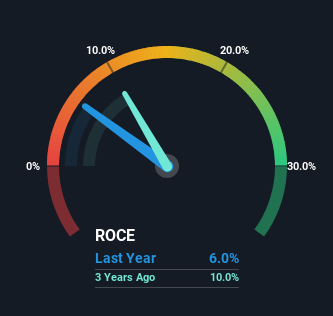- Hong Kong
- /
- Water Utilities
- /
- SEHK:270
Guangdong Investment's (HKG:270) Returns On Capital Not Reflecting Well On The Business

There are a few key trends to look for if we want to identify the next multi-bagger. One common approach is to try and find a company with returns on capital employed (ROCE) that are increasing, in conjunction with a growing amount of capital employed. Basically this means that a company has profitable initiatives that it can continue to reinvest in, which is a trait of a compounding machine. However, after investigating Guangdong Investment (HKG:270), we don't think it's current trends fit the mold of a multi-bagger.
What Is Return On Capital Employed (ROCE)?
For those that aren't sure what ROCE is, it measures the amount of pre-tax profits a company can generate from the capital employed in its business. Analysts use this formula to calculate it for Guangdong Investment:
Return on Capital Employed = Earnings Before Interest and Tax (EBIT) ÷ (Total Assets - Current Liabilities)
0.06 = HK$5.7b ÷ (HK$140b - HK$46b) (Based on the trailing twelve months to December 2023).
Therefore, Guangdong Investment has an ROCE of 6.0%. Even though it's in line with the industry average of 6.0%, it's still a low return by itself.
See our latest analysis for Guangdong Investment

Above you can see how the current ROCE for Guangdong Investment compares to its prior returns on capital, but there's only so much you can tell from the past. If you're interested, you can view the analysts predictions in our free analyst report for Guangdong Investment .
So How Is Guangdong Investment's ROCE Trending?
In terms of Guangdong Investment's historical ROCE movements, the trend isn't fantastic. Around five years ago the returns on capital were 8.7%, but since then they've fallen to 6.0%. Meanwhile, the business is utilizing more capital but this hasn't moved the needle much in terms of sales in the past 12 months, so this could reflect longer term investments. It may take some time before the company starts to see any change in earnings from these investments.
While on the subject, we noticed that the ratio of current liabilities to total assets has risen to 33%, which has impacted the ROCE. Without this increase, it's likely that ROCE would be even lower than 6.0%. While the ratio isn't currently too high, it's worth keeping an eye on this because if it gets particularly high, the business could then face some new elements of risk.
Our Take On Guangdong Investment's ROCE
To conclude, we've found that Guangdong Investment is reinvesting in the business, but returns have been falling. And investors appear hesitant that the trends will pick up because the stock has fallen 65% in the last five years. On the whole, we aren't too inspired by the underlying trends and we think there may be better chances of finding a multi-bagger elsewhere.
Guangdong Investment does have some risks, we noticed 3 warning signs (and 1 which doesn't sit too well with us) we think you should know about.
While Guangdong Investment isn't earning the highest return, check out this free list of companies that are earning high returns on equity with solid balance sheets.
New: Manage All Your Stock Portfolios in One Place
We've created the ultimate portfolio companion for stock investors, and it's free.
• Connect an unlimited number of Portfolios and see your total in one currency
• Be alerted to new Warning Signs or Risks via email or mobile
• Track the Fair Value of your stocks
Have feedback on this article? Concerned about the content? Get in touch with us directly. Alternatively, email editorial-team (at) simplywallst.com.
This article by Simply Wall St is general in nature. We provide commentary based on historical data and analyst forecasts only using an unbiased methodology and our articles are not intended to be financial advice. It does not constitute a recommendation to buy or sell any stock, and does not take account of your objectives, or your financial situation. We aim to bring you long-term focused analysis driven by fundamental data. Note that our analysis may not factor in the latest price-sensitive company announcements or qualitative material. Simply Wall St has no position in any stocks mentioned.
About SEHK:270
Guangdong Investment
An investment holding company, engages in water resources, property investment and development, department store operation, hotel ownership, energy project operation and management, and road and bridge operation businesses.
Excellent balance sheet, good value and pays a dividend.
Market Insights
Community Narratives



